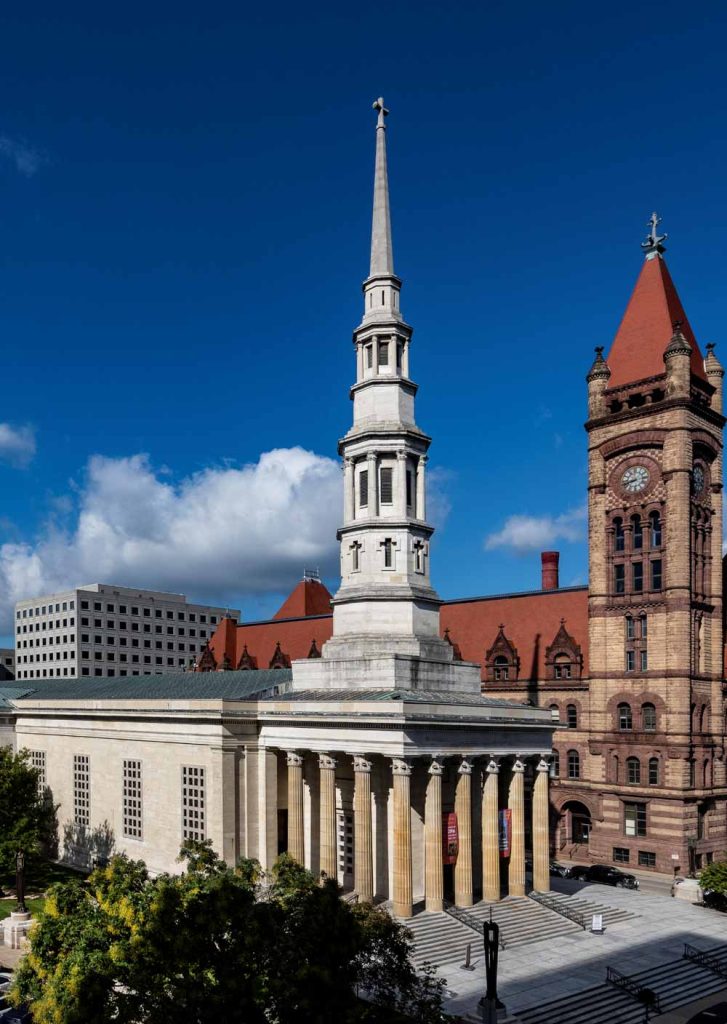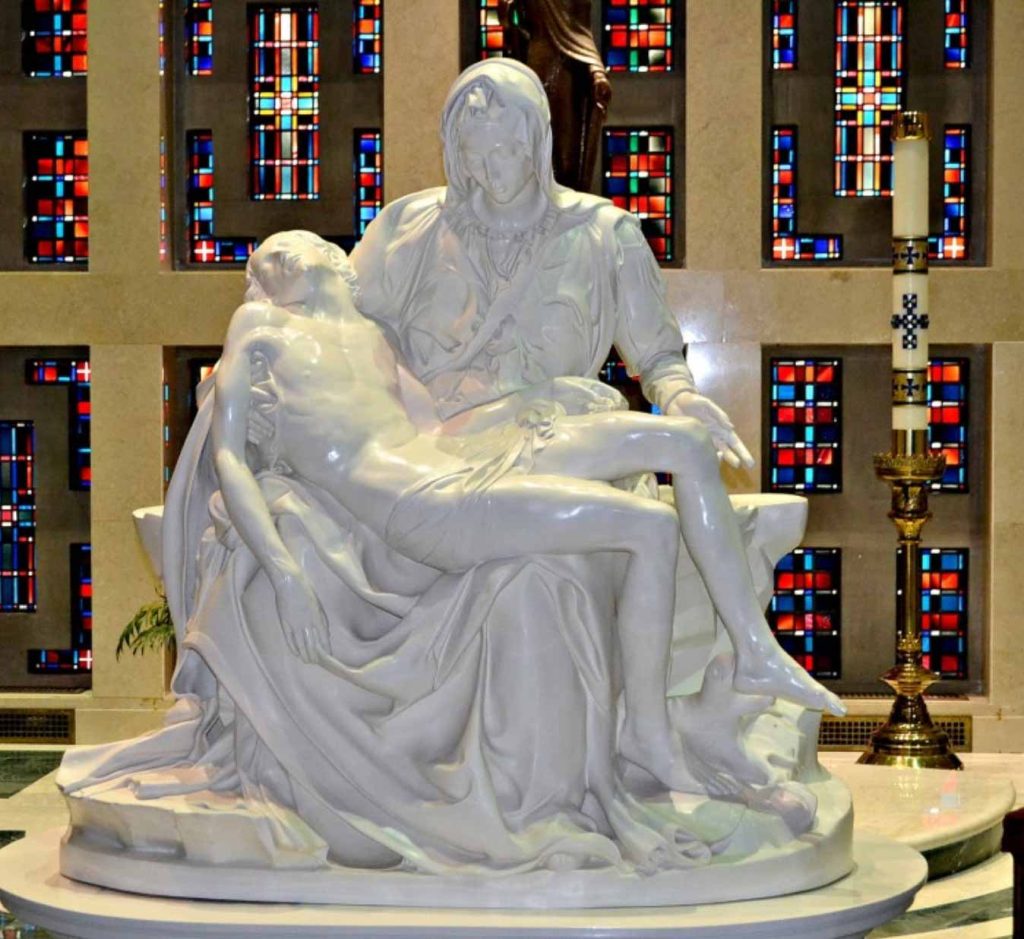Explore the beauty of one of Cincinnati’s most revered treasures.
Saint Peter in Chains Cathedral is the cathedral of the Roman Catholic Archdiocese of Cincinnati. It is a Greek revival structure located at 8th and Plum Streets in downtown Cincinnati.

Saint Peter in Chains was begun with the laying of its cornerstone on 20 May 1841, under the direction of then-bishop (later archbishop) John Baptist Purcell, and formally dedicated on 2 November 1845.
Its striking single spire, which soars to two-hundred and twenty feet above street level, was the tallest man-made structure in the city for many decades, and is constructed of pure white limestone.
It required 18 months to set in place the large quantities of marble used in the 1957 restoration of the Cathedral. In all, workers set in place about 600 tons of marble: 15,000 square feet of flooring, wall surfaces, stairs and altars. The marble-setters worked mainly in five kinds of marble:
A lustrous jet-black stone quarried near Knoxville, Tennessee, used for the walls of the atrium, the wainscoting in the narthex and the nave, and the columns leading to the Baptistry and Blessed Sacrament Chapels.
A rich dark green marble from Italy used primarily for the flooring throughout the building.
A white Italian marble used primarily in contrast to the green to form the pattern in the flooring.
A French marble, midnight blue lightly veined with white; used for the massive fluted columns of the main altar.
A white marble tinged with cream used in the pulpits, for the walls of the sanctuary, Baptistry and Blessed Sacrament Chapels, and for the altar in the Blessed Sacrament Chapel.
The Venetian glass mosaic which fills the rear wall of the sanctuary is the largest such work in the States, 35 feet high and about 40 feet wide.
Its design, based on the ideas of Archbishop Alter, was developed by Anton Wendling, a professor of the University of Aachen, Germany, and associate artist of the T.C. Esser Stained Glass and Mosaic Studios in Milwaukee.
The thousands of small pieces of stone and glass were produced and mounted in reverse on linen by highly skilled craftspeople in the United States and Germany. Under the supervision of master craftsman Erhard Stoettner, skilled craftspeople, brought from Germany under a special permit issued by the State Department, installed the mosaic in mortar on a masonry background.
Stoettner described the mosaic in a commemorative booklet published by the Catholic Telegraph at the time of the Cathedral’s rededication in 1957.
As one enters the Cathedral, one is awed by the vision of a majestic wall of gold mosaic dominated by a heroic concept of the figure of Christ seated on a throne. His garment is resplendent in various shades of rich rubies embellished with gold stars, symbolic of Christ’s burning love and sacrifice for the salvation of men. Here is a youthful Christ, his youth indicating that the Church is ever vital and unchanging amid the changes of time. He extends His right hand in blessing. With His left hand, He gives the keys of authority to Saint Peter who kneels before Him. The Saint’s figure is surmounted by a tiara, symbolic of the papacy.
To the left, below the figure of Christ, the mosaic portrays the miraculous release of Saint Peter from the prison in Jerusalem. His deliverer, an angel, loosed his chains and led Him to freedom. In the opposite corner, the mosaic again portrays a prison scene, showing Saint Paul, the great preacher and symbol of the Church Militant, visiting Saint Peter in the Mamertine prison in Rome.
The panel shows the two Apostles strengthening one another spiritually before going to their martyrdom. Both the prison scenes are surmounted by architectural elements symbolic of the cities in which Saint Peter was imprisoned. In the center, below the figure of Christ, a Latin text is inscribed: Et Petrus Quidem Se,vabatur in Carcere Vinctus Catenis which translates: And Peter was kept in prison, bound in chains. (Acts 12:5)
The original tower bells were cast by George L. Hanks of this city in 1851 and dedicated on Jan.11, 1852.
A tower clock by Francis Stein (or Steine) was connected to those bells by July 4, 1852, and played tunes automatically at 3-hour intervals. The clock was replaced in the 1930s by the Verdin Co. of Cincinnati; the chime was sold and moved in 1955 to Saint Teresa of Avila in Cincinnati.
The hour bell cast by Hanks in the same year (1851) remains, and was rededicated along with a new set of 12 dutch bells on February 24, 1957 cast by the Petit and Fritsen Royal Bellfoundry of the Netherlands. In 2010 the tower bells were completely refurbished by the Verdin Co. of Cincinnati and a new keyboard and automatic playing mechanism was installed.
The bells were formally rededicated on Sunday, November 21, 2010, the Feast of Christ the King.

One of the Cathedral’s processional crosses has a corpus by Benvenuto Cellini (1500-1571), probably the most gifted goldsmith in history. Few of his works have found their way to the United States.
The gilt bronze figure, 131 inches high, was originally in the private chapel of the Palazzo Guadagni in Florence. Purchased at auction by the Cincinnati Art Museum, it was repurchased
with contributions collected mainly by the Cincinnati Post and presented to the Cathedral in 1957.
We are pleased to announce that we have received the necessary funding to keep the replica statue of Michelangelo’s Pieta as a permanent asset to the Cathedral. On December 8, 2018, the Solemnity of the Immaculate Conception, Archbishop Schnurr blessed the Pieta. Since then, thousands of parishioners, tourists, and pilgrims have come to see this most beautiful sculpture. We are very grateful to the benefactors and friends of the Cathedral who have generously made possible this Divine work of art depicting the greatest gift our Lord has given us, His Son, as a permanent exhibit at St. Peter in Chains Cathedral for generations to come.
The Pieta is located in the baptistery, to the right of the main altar and opposite the Blessed Sacrament Chapel. Public viewing is available Monday through Friday from 6:30am – 6:00pm, Saturday from 11:00am – 6:00pm and on Sundays from 10:30am-1:00pm. Please visit us to take in this brilliant work of art.


The coat of arms of the cathedral church of the Archdiocese of Cincinnati evokes its dedication to God in honor of Saint Peter in Chains.
The crossed keys represent Saint Peter, alluding to the words of Jesus in Matthew 16:18-19: “You are Peter, and upon this rock I will build my church … I will give you the keys to the kingdom of heaven.” The chains recall Peter’s imprisonments, first in Jerusalem (Acts 4, 5, and 12) and finally in Rome. Keys and chains are found as decorative motifs throughout the cathedral.
The colors of the arms, red and gold, are the ancient colors of the church of Rome, “the See of Peter,” and of the coat of arms of the Archdiocese of Cincinnati.
The red and gold processional canopy or ombrellino above the shield indicates that on June 29, 2020, the solemnity of Saints Peter and Paul, Pope Francis designated this historic church a “minor basilica.” The ombrellino is a canopy formerly carried over the pope, now used as an emblem of the Holy See and of churches honored with the title of “basilica,” a term originally used for the major churches of Rome.
The gold and silver keys crossed and joined by a red cord are one of the oldest heraldic emblems of the pope who, as successor of Saint Peter, holds the keys of authority to bind and loose on earth and in heaven (Matthew 16:19). Placed behind the shield of the cathedral, the keys indicate that the dignity of a minor basilica was conferred upon this church by the authority of the Holy See.
Below the shield is the motto of the cathedral: “In Vinculis Vinco,” “In chains, I conquer!” The motto expresses the confidence, inspired by the example of Saint Peter, that, even when bound with chains and condemned to death, in Christ we are victorious.
In the technical language of heraldry, the arms of the cathedral are described as: Or two Keys in saltire wards upward and outward within an orle of Chains Gules the ecu ensigned by a basilical Pavilion proper and two Keys in saltire wards upward and outward Or and Argent corded Gules.
While somewhat familiar to Catholics, the term Basilica originally referred to a specific function and style of building in use during the time of the Roman Empire. A Basilica was a public building used by the Emperor or Judges for major events of noble import or significance. The structure was usually distinguished by columns, a long center aisle, and an apse within the building. It was into the apse that the Emperor or Judge would be seated.
As Christianity became the official religion of the Roman Empire, Basilicas were converted into churches, with the Altar and Tabernacle of Our Lord, Jesus Christ substantially present in the apse, the place once occupied by the Emperor. The Basilica thus became the “Royal House” that fulfilled the architectural and canonical functions that raise it to a place of honor and privilege.
There are two types of basilicas – Major Basilicas and Minor Basilicas. First among the Major Basilicas is the Lateran Basilica of Saint John, which is the Pontifical Cathedral of the Holy Father as the Bishop of Rome.
There are four major basilica’s in Rome: the Lateran Archbasilica of Saint John, the Vatican Basilica of Saint Peter, Basilica of Saint Mary Major, Basilica of Saint Paul-Outside-the-Walls. There are three papal minor basilicas, one in Rome, Basilicia of St Lawrence Outside the Walls, and two in Assisi associated with Saint Francis of Assisi situated in or near his home town.
Minor Basilicas are those churches throughout Christendom that have been given a special designation by the Holy Father. Reasons for bestowing this designation may be granted for architectural beauty, historical significance, liturgical renown, or for any combination of these attributes. A Minor Basilica shares a special relationship with the See of Rome and with the Holy Father. Various privileges and obligations of the Minor Basilica highlight this important attachment to the Holy See and the Supreme Pontiff.

Tours at St. Peter in Chains
Monthly public tour Second Sunday of each month immediately following the 11:00am Mass. The guided tour is free and focuses on the history and architecture of our cathedral church. Private group tours can also be arranged during the week.
"*" indicates required fields
Cathedral Basilica of St. Peter in Chains
Parish Office Hours
Monday – Friday: 8:30 AM – 4:30 PM